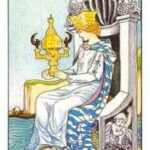
The Lovers
Our goal in the emotional domain is to feel and sustain the positive emotions of love and pleasure. This need arises from the instinct for sex. For primitive humans whose struggle for survival must have consumed almost every waking moment, sex was one of the few activities that took them away from the daily grind of work and provided emotional satisfaction, if only briefly. Even today, most people still find it extremely difficult to separate their desire for love and pleasure from their desire to have sex with another human being.
Interestingly, the two parts of the brain responsible for emotions and instincts adjoin one another. The so-called reptilian brain at the top of the spinal cord is the bottommost portion of the brain. This brain stem appears to be the source of our instincts. The limbic system, the portion of the brain that processes emotions, is the next higher level which flares out and over the brain stem.
These two parts appear to have developed very early in our evolution at a time when the primary task of the human species was to survive. The cerebral cortex is a more recent addition. This is a wider, double-hemispheric mass that rises above the brain stem and limbic system. Psychologically, we can say that the two lower parts of the brain contain the most basic and deeply unconscious aspects of our mental functioning and correspond with the unconscious self, or other. Likewise, the cerebral cortex is the realm of conscious selfhood, or ego. Because our emotions and instincts “lie beneath” our conscious awareness, it is extremely difficult for us to understand or deal with them in controlled, rational ways.
The emotional energy of our instinct for sex fuels not only sexual passion but also spiritual passion. The archetypes which represent it are the Lover and the Beloved. One way to see them is as personifications of self and other, our conscious and unconscious emotional lives. From this perspective, the Lover represents our ego’s sense of selfhood and concerns about self-preservation: our desire for self-development, our longing for fulfillment, our passion to become individuated and enlightened.

Image from a Greek Vase
A strong, heroic Lover feels great passion; a weak one fears and represses emotions, especially tender ones. A brave Lover recognizes his desires and honors his powerful appetite; a deeply wounded one barely allows himself to want anything at all. A mature Lover understands the dangers of excesses and maintains some discipline and self-control; an immature one cannot control his emotional life, develops addictions, or swings from one emotional extreme to the other.
The Beloved can likewise be awake or asleep, strong or weak, brave or cowardly. An immature Beloved is not open, authentic, or intimate with Otherness, including the Great Mystery, other people, our shadows, or our contrasexual opposites of anima or animus. In this unconnected state we project our disowned emotions onto people and activities that we expect to satisfy our deepest emotional needs, and when things go wrong we blame them. But the true culprit in dysfunctional relationships is our fear of opening emotionally to Otherness, both human and divine. It is our ego’s lack of feeling that creates problems with the very people in whom we invest our hope for love and pleasure. The antidote is to know and feel compassion for our rejected selves.
How are you doing in the emotional realm? When do you fail to feel love for yourself?
Please note: Syndicated talk show host Al Cole is airing a radio interview with me about my new book, Healing the Sacred Divide, on his show “People of Distinction.” You can listen in at this link. I hope you enjoy it.

Living in a Culture That’s Lost Its Heart
“To learn how to fully live Eros makes a major contribution to the world around me, because this is a culture that’s lost its heart;



0 Responses
Reblogged this on mermaidcamp and commented:
Where do you keep the rejected parts of yourself?
Great question. Have you received any answers yet?
I made a technical mistake, Jean, and do not find the post now..I want to try again..love this one.
Odd. Neither your comment nor your “like” is showing up now.. Do please try again.